This is Chapter Two in the beta-reader serialization of The Sexualization of Islam, a 13-part, nonfiction enquiry into how Western ideas of the Orient, and Islam in particular, were shaped by artists’ visions of the exotic and erotic.
For the Prologue to this series, please click here. For Chapter One, please click here.

WHEREVER MEN AND WOMEN COME TOGETHER in unequal relationships of power, a master-slave dynamic is at work.
The notion that male-female relationships are fundamentally transactional between two (or more, in the case of polygamy) parties is challenged when a woman constitutes physical property to be purchased, sold, used, and abused without her consent. This is the reality of all genuine slave markets and the physical entrapment of women in harems and households. In the Islamist master-slave dynamic, there is no “safe word.” One doesn’t just get dressed and go home afterwards.
My favourite Orientalist is the Sevilla-based painter José Jimenez Aranda (1837–1903) who mentored several major Spanish artists such as Gonzalo Bilbao, Daniel Vázquez Díaz, Eugenio Hermoso, Ricardo López Cabrera, Manuel González Santos, and Sanz Arizmendi, all of whom participated in the Costumbrismo and Orientalist Movements at some point in their artistic trajectories.
“A Slave for Sale” is emblematic of Aranda’s work. The placard inscribed in Greek letters on the merchandise for sale in an Arabian bazaar states: “Rose, 18 years old, on sale for 800 coins,” informing prospective buyers that the captive is a white Christian woman and therefore expected to bring a high price.
For narrative effect, the artist places the viewer’s eyes at the level of the lecherous males ruminating on what thrills and delights may accrue to her eventual purchaser. Her collapsed posture and pose of abject humiliation and despair suggest that she is a virgin who may languish on the market until a high enough selling price is realized, hanging her head in abject misery as rough men, depicted only by their unwashed feet and greasy caftans, contemplate her defenceless nudity.
Aesthetically, Aranda’s controversial subject matter is supported by masterful composition, leading the viewer’s eye straight to the object of the men’s interest, that is, the woman’s pubic zone. Like Fortuny and Fabrés, Aranda has exposed the figure’s right breast. His chilling palette of ochres, blues, and greys – what later came to be known as the “Zorn palette” [1] – emphasizes dirt and bruising as if the shamed woman’s lifeblood were being drained into the earth, one metaphorical drop at a time. Ironically, this portrait of humiliation and pain elicits a potent cocktail of lust and condemnation that constituted a powerful social statement for its time.
Aranda’s is not a painting meant to match the drapery and complement the IKEA sofa.

The first commodity allegedly traded by humanoids was slaves. Unsurprisingly, the characteristic qualities of a marketable slave have not changed throughout history. Men must be strong and able-bodied while women must be sexually alluring. The oldest, most successful, most expert and enduring practitioners of slave trading have been Arab-Muslims.
Skin, hair, eye colour, age, and virginity significantly impacted the selling price of a sex slave. The highest values were brought by virgin European girls and women between the ages of 10–35 years and teenage boys. The lighter their skin, the higher price they brought in the marketplace. Light skinned, blue-eyed Circassian women were prized above all and fetched the highest prices.
The Circassian woman appears in Lord Byron's Don Juan (1818–1824), in which the description of a slave auction is offered:
Some went off dearly; fifteen hundred dollars
For one Circassian, a sweet girl, were given,
Warranted virgin. Beauty's brightest colours
Had decked her out in all the hues of heaven.
Her sale sent home some disappointed bawlers,
Who bade on till the hundreds reached the eleven,
But when the offer went beyond, they knew
'Twas for the Sultan, and at once withdrew.
— Don Juan, canto IV, verse 114
According to contemporary estimates, hundreds of thousands, if not millions, of Europeans were captured by Barbary (North African) pirates and sold into slavery or held as hostages for ransom.
The Muslim demand for, in the words of one historian, “white-complexioned blondes, with straight hair and blue eyes,” traces back to the prophet of Islam, Muhammed, who enticed his followers to wage jihad against neighboring Byzantium by citing its blonde (“yellow”) women awaiting them as potential concubines.
According to the conservative estimate of American (Ohio State University) Professor Robert Davis, “Between 1530 and 1780 [alone] there were almost certainly a million and quite possibly as many as a million and a quarter white, European Christians enslaved by the Muslims of the Barbary Coast,” that is, of North Africa, the telling setting of the (Gerome’s “Slave Market”) painting. By 1541, “Algiers teemed with Christian captives, and it became a common saying that a Christian slave was scarce a fair barter for an onion.”
Davis’s treatise on the white slave trade cites “a million victims from France and Italy to Spain, Holland, Great Britain, the Americas, and even Iceland in the centuries when it flourished between 1500 and 1800. Whether dealing with the methods used by slavers, the experience of slavery, or its destructive impact on the slaves themselves, Davis demonstrates the many often surprising similarities between this ‘other’ slavery and the much better-known human bondage suffered at the very same time by black Africans in the Americas.” (Source) [2]
Sub-Saharan (i.e., Black) Africans brought much lower prices in the North African and Ottoman markets. For example, in the 1600s, a young white virgin commanded the same price as a large, two-storey house with a garden while a handsome teenage boy was worth the equivalent of 500 kilograms of lamb meat. Taxes applied to the purchase of slaves, but female war captives were allowed gratis to soldiers (i.e., jihadis) as incentives to participate in military excursions, equivalent to today’s Islamic State (ISIS) policy in zones under its control. Ottoman armies had no trouble attracting enthusiastic mercenaries as they assaulted the gates of Vienna with over 100,000 men in arms in 1529.
In his classic novel “Don Quixote,” Spanish author Miguel de Cervantes (1547-1616) describes how Christians were routinely kidnapped from ships and small boats in the Mediterranean and even from the Iberian Peninsula itself, then transported to North Africa for sale. Males and older women were housed in holding pens awaiting ransom through intermediaries by their families and friends back home while younger women and girls disappeared into households and harems.
Religious orders such as the Mercedarians were established for the express purpose of ransoming kidnapped Christians from their Muslim captors. Everybody on the African side of the Mediterranean, except the unfortunate captives, earned good money in the slave trade of which Cervantes had acquired first-hand knowledge. [3]
In the summer of 1570, Cervantes joined a Spanish regiment at Naples as a naval gunner. He fought against the Turks in the Battle of Lepanto on 7th October 1571, a critical engagement in which the fate of Europe as a Christian continent was decided, and where he received a wound which crippled his left arm for life. After another battle in Tunis and a short respite at Naples, Cervantes was returning to Spain when his ship was attacked by Barbary pirates. He was taken captive to Algiers and held for ransom for five years. His experience and time in Algiers in reflected in “The Captive’s Tale” (Don Quixote, First Part, Chapters 29 to 41).
Speaking of the Battle of Lepanto at which Islam was turned back, Cervantes recounts:
“…fifteen thousand Christians – all of them rowers for the Turkish fleet – regained their longed-for freedom that day.”
Cervantes himself wasn’t so fortunate.
Like slave patrollers of the pre-Civil War United States (Northern sheriffs who captured runaway slaves then returned them to their Southern owners for a fee), the recapture of runaway slaves was a lucrative spin-off in a semi-nomadic society whose economic driver was slave trading. Once purchased, a sex slave (or any enslaved person) could be rented out, gifted to another owner, or even killed without repercussions.
Gerome’s painting “Slave Market” has been repurposed by The Alternative for Germany Party (AfD), founded in 2013, and first elected to Germany’s national parliament in 2017. This right-wing, anti-immigrant group has been distributing posters of the painting with the slogan, “So that Europe won’t become Eurabia.” The message is clear: men of colour exploiting white women. Adolph Hitler would have delighted in the re-emergence of racial stereotyping.

Horace Vernet’s “The Slave Market” was created during a time when the slave trade in Black Africans had only recently been outlawed under English and French law, but chattel slavery continued to flourish in both North and South America. The United States of America boasted a Black slave population of over four million amongst a national census of only thirty million with auction blocks doing a brisk business in both imported and homegrown slaves across the Southern States. There is plenty of historical testimony that white masters exploited their female slaves to satisfy carnal urges, President Thomas Jefferson — author of the famous “all men are created equal” dichotomy — standing out amongst many high-profile practitioners.
Despite indisputable evidence of Muslim domination of the industry, the Prophet Muhammed did not invent slave raiding and sexual slavery which has been with humankind since the dawn of recorded history. His followers’ achievement was in having codified it in the Quran and implementing slave raiding on an industrial scale. The trade in both Black and white slaves during the last millennium owes its genesis and economic success to Islam.

Before Julius Caesar came, saw, and conquered the Gauls, thereby flooding Roman slave markets with light-skinned, blond haired, blue-eyed women, girls, and boys, the Etruscans had already made sex slavery an integral part of their cultural heritage. Had this technologically advanced and artistically gifted civilization succeeded in defeating the emerging Roman Empire in battle, theirs would have become the Western paradigm.
Unlike the Islamists who later evolved from the Abrahamic tradition (Judaism - Christianity - Islam), the ancient Israelites did not wage distant or large-scale wars, hence captured slaves did not make up a significant portion of their holdings, most of whom were enslaved domestic servants and sex slaves purchased in the market. Nonetheless, the taking of sex slaves in battle is advocated in Numbers 31 wherein Moses instructs his soldiers to kill all women who had ever had sexual relations with a man, but to keep the women and girls who were still virgins as sex slaves for themselves.[5] Note the emphasis on the capture of virgins who, in that day and age, would have been mostly prepubescent girls.
Deuteronomy 21:10–14 not only condones sexual violence against defenseless women captives but endorses sexual slavery and genocidal rape of non-Hebrews. Like the Quran prohibits the enslavement of free Muslim women while excluding all non-Muslims, the Bible is the progenitor for this earlier precept that Mohammad lifted holus bolus from Hebrew scripture.
The Hebrew words amah (אָמָה) and shifhah (שִׁפְחָה) denote female slaves used as sexual objects. Leviticus 18-26 expands on the prohibitions alluded to by Christianity’s Nineth Commandment (Thou shalt not covet thy neighbour’s wife) while explicitly allowing participation in the sex slave trade.
“Both thy bondmen, and thy bondmaids, which thou shalt have, shall be of the heathen that are round about you; of them shall ye buy bondmen and bondmaids.” (Leviticus 25:44)
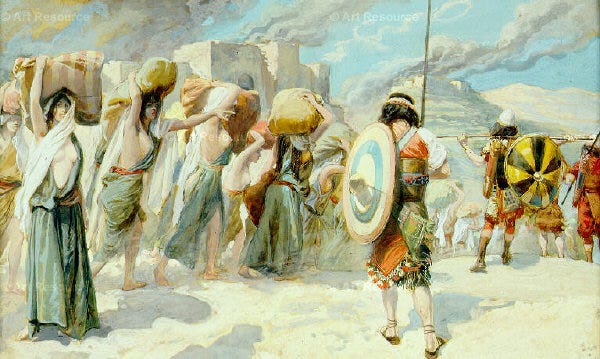
Every hostile exchange throughout human history has turned women of the conquered, or so-called liberated, territories into rape victims and whores. By its very nature, slave raiding is an act of war inflicted upon an unwilling populace, or what in post-modern terms is called “bullying” (the disproportionate use of power for personal or national satisfaction and enrichment) on a massive scale. In a socio-religious context, Islam has always been a formidable bully in the world. Islamists, in turn, extend that honour to present-day Israel.
Aranda’s painting “The Slave Market” is discussed earlier in this chapter. In the photograph, a Yazidi woman is allegedly sold to Saudi Arabian buyers in an ISIS slave auction. So far, an estimated 3,485 Iraqi Yazidi women have been abducted and sold into sexual slavery by ISIS. Saudi Arabia is a key American and United Kingdom ally.


Here is the old matter of the pot calling the kettle black. Whether Islam, Judaism, or Christianity can even be called religions of peace is highly debatable, given that the Prophet himself exhorted his followers to put all who refused to accept his message to the sword while both the Bible and the Quran authorize and encourage men to engage in sex with their female captives and slave girls.
“Not so the worshippers, who are steadfast in prayer, who set aside a due portion of their wealth for the beggar and for the deprived…who restrain their carnal desires except with their wives and slave girls, for these are lawful to them” Quran 70:22–30
“And all married women are forbidden unto you save those captives whom your right hands possess. It is a decree of Allah for you.” Quran 4:24
The Quran authorizes and encourages sexual relations between a master and his female slaves outside marriage, referred to as ma malakat aymanukum, translated as "what your right hands possess." The term is found in at least 15 Quranic passages referring to slavery and the possession, use, and abuse, of women against their will. A Muslim may have sexual relations, but not cohabit with, a slave woman belonging to his legal wife; so, perhaps at least some restrictions are aimed at maintaining domestic harmony. More recently, imams speaking for ISIS in Iraq have issued a series of fatwas pertaining to the treatment of sex slaves, none of which are in the least favourable to the captive women.
Muslim-ruled countries have earned their reputation for industrial-scale kidnapping, slave trading, and sexual slavery, while Islam is currently the only religion that openly endorses the practice. According to World Population Review, 167 mostly-Muslim countries, affecting an estimated 46 million slaves, still condone forced bondage as defined by the U.S. Department of State as "the act of recruiting, harboring, transporting, providing, or obtaining a person for compelled labor or commercial sex acts through the use of force, fraud or coercion."[8]

There is a curious historical parallel between the centuries of depredations to shipping and coastal raids by Barbary pirates and the consequent 19th century American-European military campaigns directed at suppressing their activities by force, and maritime piracy today. In both eras, humans were/are held for ransom, women being subjected to sexual abuse by their abductors, most recently during and after the October 7, 2023 Hamas attack on Israel.

Dr. Christopher Hitchens and other respected historians have estimated that approximately 1.5 million Europeans and Americans were taken captive by Tripolitan pirates during 1750-1850. In 1775, the United States was barely a country when U.S. representatives approached the Algerian ambassador in Paris asking “Why are you doing this to us? We have never had a quarrel of any kind with your nation nor with the Muslim world at large. We weren’t in the Crusades. So, why do you plunder our ships and enslave our people?”
Ambassador Abdul Rahman’s response was that, since the Quran authorized them to raid shipping and enslave non-believers, that’s exactly what they would continue doing.
According to Wikipedia: While the United States did secure peace treaties with the Barbary states, it was obliged to pay tribute for protection from attack. The burden was substantial: from 1795, the annual tribute paid to the Regency of Algiers amounted to 20% of the United States federal government’s annual expenditures.
To put the foregoing into context, The U.S. Congress approved a 2022 federal budget of $6 trillion. If 20% were dedicated to extortion by a single foreign power, the payout would reach $1.2 trillion. By comparison, the United States spent $2.2 trillion on fruitless military adventuring in Afghanistan, Iraq, and Syria from 2001 through 2021, none of which contributed to curtailing slavery or improving the dismal status of women in those countries.
War with Barbary pirates had been raging for some 300 years before the British, French, Dutch, and American governments sent their combined fleets to bombard Algiers while interdicting maritime raiders in the Mediterranean, as today’s anti-piracy coalition seeks to interdict Yemeni and Somali pirates in the Gulf of Aden, Arabian Sea, and Indian Ocean. Depredations were only brought under control after the French invasion and colonization of Algeria in 1830. Smaller scale slave raiders nonetheless continued to prey on coastal villages of southern Spain, the Balearic Islands, Sicily, Sardinia, and Corsica until the turn of the 20th century, although on a reduced scale. The coast of Andalusia (Spain) is only 32 kilometers from Tunisia.

Penalties imposed on Muslim pirates and slave raiders by the Western powers were typically as severe as those imposed by their own Sharia courts for other crimes, although according to their Prophet, they were doing nothing wrong. Under English Admiralty law, the pirates were liable upon conviction to be slow-hanged until semi-conscious, then drawn and quartered, a spectacularly gruesome and painful death. All pirates were subject to summary execution (hanged from the yardarm, walk the plank) if captured in battle. The United States was equally unsympathetic to their predatory occupation, life imprisonment being the minimum penalty. Under contemporary international law and the invocation of universal jurisdiction, those committing piracy on the high seas, whatever the booty sought, earn the status of hostis humani generis (enemy of humankind).
Despite an impressive effort by Western countries to curtail Arab piracy and slave raiding in the 19th century, the institution has lingered well into the 21st. It’s revival in the digital era is unsurprising given the territorial gains of ISIS, Boko Haram, and other Islamic fundamentalist groups, a growing international market for sex slaves, and the nine-million-and-counting recent influx of Muslim migrants into the United Kingdom and European Union countries, many of whom celebrate the atrocities committed by their coreligionists.
The exhortations of the Quran to murder those resisting conversion to Islam, along with reassuring Muslim males of their God-given right to rape non-Muslim women regardless of how or where they find them, are totally incompatible with the rights and freedoms guaranteed by the constitutions of all Western democracies. Herein lies the rub.
Easy access to women has long been used by governments and warlords like the historical Muhammed to entice uneducated or brainwashed males to action, either from a chivalric standpoint or as so-called “spoils.” The Japanese did it during the “Rape of Nanking.” The Soviets did it when they took Berlin in 1945.
When Generalissimo Francisco Franco, with the assistance of Adolph Hitler’s Luftwaffe, ferried 70,000 Muslim mercenaries from North Africa to help overthrow the Spanish Second Republic in 1936, the hired troops were authorized at the highest level and encouraged by their white officers to rape and pillage at will and that is exactly what they did. Franco’s 1939 victory led to 45 gruesome years of repression, what Hispanic historians call “Los Años Negros (The Black Years),” and the only fascist dictatorship to survive on the European continent after World War II.
An undeniable fact is that sexual exploitation of captive women is a fundamental tenet of the Quran. It is what the Prophet himself did and urged future generations of his followers to do. The institution has become central to the economy of many predominantly Muslim countries as people trafficking for illicit purposes (forced labour and sex slavery) remains a potent economic driver today.
Although the Turks banned the Circassian slave trade – from which most of their light-skinned, blue-eyed sex slaves came – in 1929, slavery in Saudi Arabia and Yemen persisted until 1962, in Oman until 1970, and in Mauritania until 1981. Nonetheless, despite its illegality, slavery openly persists in most of the Muslim-majority countries in Africa such as Chad, Mauritania, Niger, Mali, Sudan, and Nigeria. Thanks to America’s CIA, and cheered on by the intrepid Hilary Clinton, post-Gaddafi Libya – another American client state – has become noteworthy for its emerging slave markets.
Many “liberalized” Muslims argue that their subscription to the tenets of Islam does not mean that they personally condone sexual slavery or religion-driven violence against non-Muslims. At the same time, they conveniently ignore the fact that the murder of all Jews in the world is written into the Hamas constitution and foundation documents of practically every fundamentalist Muslim organization, taught in Islamic schools, and encouraged by children’s television in Muslim countries. These so-called moderate Muslims, such as London’s Lord Mayor Sadiq Khan, are desperate to deflect condemnation by their coreligionists away from themselves. Telling it like it is attracts the wrong kind of energy. In a world where truth comes with a very high sticker price, both Christians and Muslims take refuge in hypocrisy and silence.
Why? Because to criticize gender may get you cancelled, but to criticize Islam gets you killed. Go ask Salman Rushdie or the 12 murdered artists and journalists of Charlie Hebdo.
Meanwhile, Islamic State (ISIS or Daesh) propagandists insist that their iconic atrocities (mass rapes, slave auctions, spectacular executions involving hanging, beheading, stoning, and burnings of the most dramatic and cruelly imaginative variety) are all in the best Islamic tradition, pointing back to the Quran for its moral authority.
Kudos to ISIS for its honesty.

Jews, Christians, and Muslims all find themselves behind the eight ball when accused of slaveholding. One of the first tasks undertaken by Christopher Columbus in the newly discovered Americas was to enslave indigenous people in the name of the Spanish Crown, transporting his captives by the boatloads to sell in Europe. Many of the recorded disputes amongst Spanish settlers themselves, as well as with local indigenous chieftains on the island of Hispaniola (now Haiti and the Dominican Republic) where Columbus established his first colony, were over native Taino women taken as sex slaves by the colonists.
While Columbus is hailed as a visionary and hero in the West, the actual motivation behind his voyages goes unacknowledged. The only reason that the Spanish crown funded his voyages at all was to find a new route to India and the Far East, the Silk Road having been closed by Muslim invasion and the emerging Ottoman Empire.
The market for white female sex slaves was voracious and rivaled the trade in Black Africans destined for manual labour in the Americas. History reads as a Who’s Who of kings, caliphs, and wealthy Muslim consumers of female flesh with a handful standing head and shoulders above the rest.
As Islam spread into South Asia and Indonesia after the seventh century, mass enslavement of women followed. The harem of Sultan Ghiyas-ud-Din Kilji (1460-1500) harem is said to have numbered over fifteen thousand and required a separate walled city of women and eunuchs. He is believed to have been poisoned by his son and successor.
Added to the consumerism evidenced by the elite, many thousands of lesser nobles and householders maintained large harems that drew heavily on the trade in light-skinned European-born women that continued into the 20th century and featured prominently in the Armenian genocide perpetrated by the Turks during the First World War. As practiced by ISIS and other contemporary Islamist terror groups, a young woman’s conversion to Islam and submission to sexual exploitation by Turkish soldiers was the only path to survival.
The abolition of chattel slavery in Western society by the mid-19th century did not occur without major pushback. Ever since Pope Nicholas V issued a series of papal bulls legitimizing the capture and enslavement of non-Christians (as Muhammed legitimized the capture and enslavement of non-Muslims), the Vatican had staunchly supported the abuses of chattel slavery.[9]
After the defeat of the Confederacy in 1865, Pope Pius IX sent a crown of thorns to deposed Confederate President Jefferson Davis, a memento on display at the Confederate Memorial Hall Museum in New Orleans. The bizarre artifact was allegedly handwoven by the Pope himself who decried the elimination of slavery as contrary to divine and natural law then declared himself infallible. Not only could non-Christian women be kidnapped and sold into slavery, but the Church encouraged them to obey their owners in every aspect.
Black female sex slaves – whom the Pope mostly had in mind – sold into the Muslim market had often been surgically altered by female genital mutilation to ensure they experienced no pleasure in sex acts while uncut white slaves were prized for their potentially more passionate embrace. In the end, the female of the human species was, and still is, treated under Islam as nothing more valuable that an insentient slab of warm meat, whatever her original religion, nationality, race, or skin colour.
Coincident with the outlawing of the transatlantic slave trade by most Western nations in the mid-19th century, images from Turkish and North African slave markets began to infuse academic painting until Orientalism emerged as a distinct genre in art. Africa and the Middle East remained the only areas where slavery persisted unimpeded, thanks to its enshrinement in the Quran where masters are encouraged to indulge their carnal impulses with both their slave girls and legal wives, as if there were something fair or even democratic in the practice. Western artists mined this rich vein of exotic-erotic material for all it was worth.
Muslim artists, on the other hand, are strictly forbidden to depict the naked human image in painting and sculpture, and especially warned against unflattering renditions of the Prophet Muhammed. The market for this style of erotic art was, and still is, the exclusive bailiwick of Western painters who spent time in Turkey, North Africa, and Egypt to soak up local ambiance, kickstarting their imaginations. Whether they visually embellished the rather large seed of truth in their visual story telling or not, Orientalist painters comprised the only chroniclers and witnesses to history before the advent of photography.
The 19th century obsession with Orientalism largely ignored what was unpalatable to European and American tastes – there are no extant paintings depicting female genital mutilation or the castration of eunuchs – and instead emphasized what appealed to the Western libido as thoroughly and fantastically erotic.
Paintings depicting white plantation owners having sexual relations with their Black slaves – a common occurrence in almost all slaveholding households across the Southern States – are also few to none, while scenes in Turkish and North African slave markets and harems dominate the genre.
There are reasons for this as we shall see.
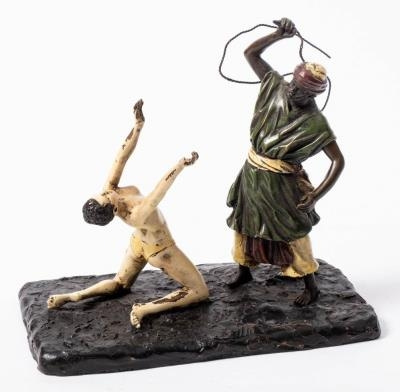
Next: Chapter Three - Harem Life, Then and Now
“Except you enthrall me, never shall I be free,
Nor ever chaste, except you ravish me…” – John Donne
Footnotes
[1] Dan Scott, The Zorn Palette, What It Is and How You Can Use It. May 14, 2016, Draw Paint Academy. https://drawpaintacademy.com/zorn-palette/
[2] Robert C. Davis, “Christian Slaves, Muslim Masters: White Slavery in the Mediterranean, The Barbary Coast, and Italy, 1500-1800.” The Ohio State University, College of Arts and Sciences, Department of History. Davis’s work has been criticized for not having consulted or referenced Ottoman documents of the period, instead relying on testimonies of those enslaved and travel narratives. Critics complain that the book does not represent the viewpoint of the enslavers, nor does it account for captured Europeans who had genuine conversions to Islam. While there is little disagreement among historians regarding the industrial-scale enslavement of Europeans by North Africans, the accuracy of Davis’s numbers has been questioned. The book has become of interest to alt-Right groups.
[3] The Royal, Celestial and Military Order of the Blessed Virgin Mary of Mercy and the Redemption of the Captives (Mercedarians) was established in Barcelona in 1218 CE (before the Spanish “Reconquista”) with the express purpose of ransoming massive numbers of Christians captured first by the Muslim onslaught in the Iberian Peninsula and later those taken by the Barbary pirates. While Islamic records are unreliable, archives of the Mercedarians and other Christian groups dedicated to the recovery of European slaves emphasize the scale and purpose of the Islamists’ traffic in enslaved persons much like statisticians track today’s people trafficking industry. Besides the exchange of money for captives, some Mercedarians offered themselves in exchange. One of their vows was: “I will be obedient to you and your successors up to death; and I will remain in person in the power of the Saracens if it be necessary for the redemption of Christ's Faithful."
[4] CBS News, April 30, 2019, U.S. museum demands Germany anti-Islam party stop using 19th-century “Slave Market” painting. https://www.cbsnews.com/news/us-museum-germany-far-right-afd-anti-islam-party-slave-market-painting/
[5] Numbers 31 comprises the 31st chapter of the Hebrew Book of Numbers and fourth book of the Pentateuch (Torah), forming the core of the Old Testament. The action is set in the areas of Moab and Midian wherein the Israelites, commanded by Moses and Phinehas, wage war against the Midianites, killing all the men and boys and consigning captured virgin women and girls to sexual slavery.
[6] There are many sources of figures pertaining to the capture and selling of Yazidis and other non-Muslim women into sex slavery. The enslaved women are being distributed throughout the Muslim world. See: https://ekurd.net/yazidi-slaves-saudi-arabia-2016-09-21
[7] See:
[8] World Population Review, Countries that Still Have Slavery 2024. The country with the most slaves is India (11.5 million) while the lowest ranking is the USA (1.09 million). According to the criteria, modern slavery includes forced child labor, forced marriage, commercial sexual exploitation, bonded labor, and forced recruitment into armed groups.
[9] Low Country Digital History Initiative (LDHI), African Labourers for a New Empire: Iberia, Slavery, and the Atlantic World, “Pope Nicolas and the Portuguese Slave Trade.” https://ldhi.library.cofc.edu/exhibits/show/african_laborers_for_a_new_emp/pope_nicolas_v_and_the_portugu#:~:text=Romanus%20pontifex%2C%20papal%20bull%20of,the%20coast%20of%20Western%20Sahara
[10] A. Moore, June 2, 2024, “Ten Facts About the Arab Enslavement of Black People Not Taught in Schools.” Atlanta Black Star. https://www.analyzingamerica.org/2023/10/703314/




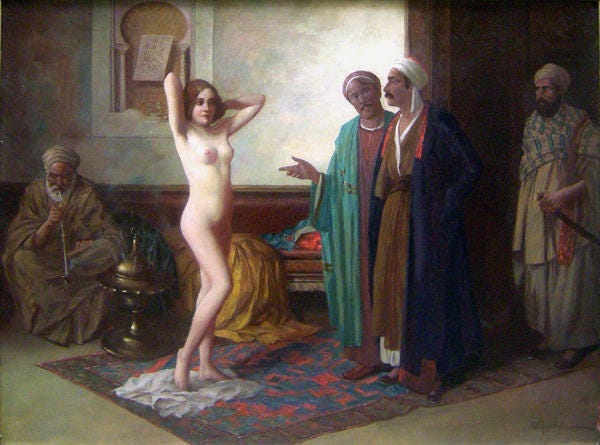


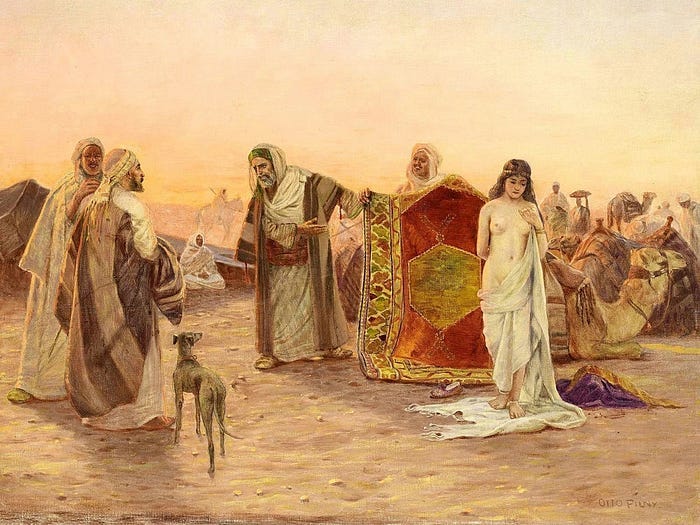

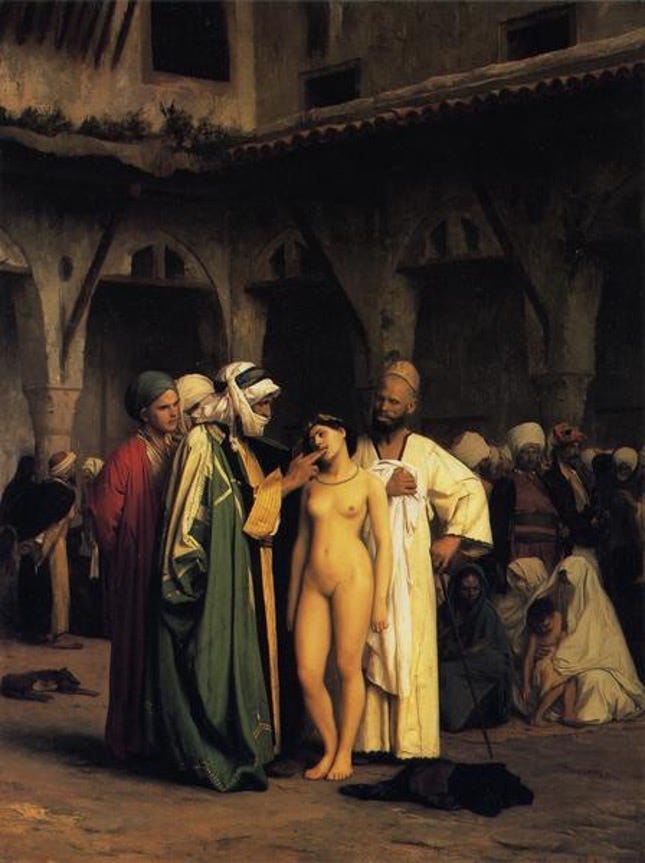
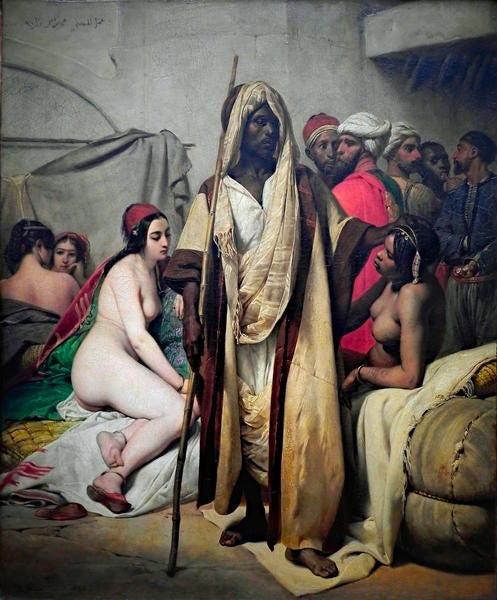

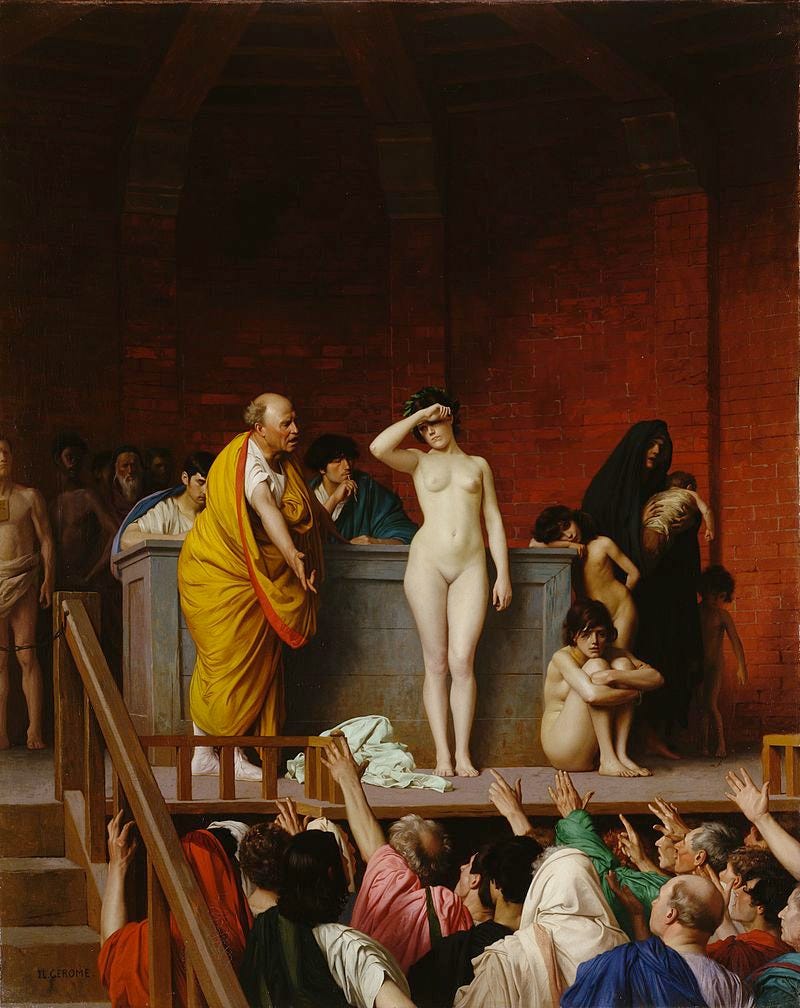

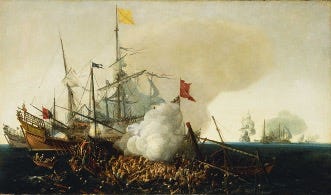

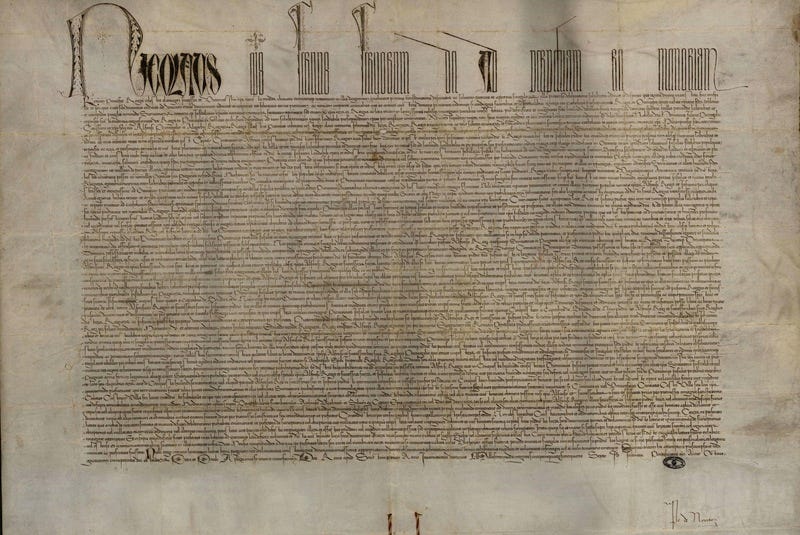


Your quotes were correct re Judaism but missed other biblical dictums creating strong constraints on the treatment of slaves including female minors who had to be released with money if they weren’t going to be married. Slave treatment and captivity and trading were vastly different between Judaism and Christianity and Islam.
C'est plutôt la sexualité des sionistes. Il n'y a pas de sexualité en Islam banane